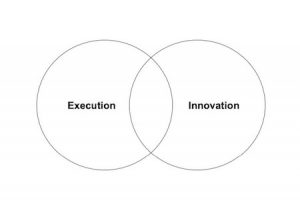
BMNT Editor’s note: This is the second in a weekly series that will explain the common beginner-steps needed to get an innovation practice off the ground or improve an existing innovation practice. Find our first post, explaining the goals of implementing a structure to guide innovation and training workers how to use it, here.
GUEST POST from Brian Miller
Private capital investors are clear about the purpose of their investments, and it’s written down in the form of a thesis or mandate. This thesis explains where they plan to invest and why. It’s used to attract capital to a fund and deploy it for a future return. Consider Not Boring Capital, a small multi-stage fund that invests in founders and companies executing on complex, non-obvious strategies aimed at huge visions.
 Government organizations seeking alignment between innovation and execution can borrow from this common practice in order to increase confidence in their investment decisions. Recall from the last post that innovation projects are not simply smaller versions of existing programs. Resources are first invested in validating a project (explore). Only after validation are significant investments made in deploying a new capability (exploit). Government leaders feel comfortable making investments in the former, but not the latter. The common risk management approach is simply avoidance, because the rewards of innovation projects seem distant and uncertain. This is magnified in the national security community, where lives are on the line and no-fail missions are prevalent.
Government organizations seeking alignment between innovation and execution can borrow from this common practice in order to increase confidence in their investment decisions. Recall from the last post that innovation projects are not simply smaller versions of existing programs. Resources are first invested in validating a project (explore). Only after validation are significant investments made in deploying a new capability (exploit). Government leaders feel comfortable making investments in the former, but not the latter. The common risk management approach is simply avoidance, because the rewards of innovation projects seem distant and uncertain. This is magnified in the national security community, where lives are on the line and no-fail missions are prevalent.
A carefully constructed innovation thesis will help to manage this risk and focus limited time, energy, and resources. It is what key stakeholders rally around. Yet it must be detailed enough for leadership, key partners, and even skeptics to understand how developing a disciplined process – an Innovation Pipeline® – will address the significant challenges facing the organization. Above all, it helps to build consensus and commitment. Otherwise, capabilities that emerge from an innovation practice will become orphans, never to be adopted by the enterprise.
What an innovation thesis consists of
Like the private sector, a public sector innovation thesis defines where to invest and why. It helps to filter out “nice to have” projects from the “must have.” It consists of two major parts:
1. A unique perspective on where relevant fields are going and the sorts of challenges that lie ahead. For example:
- Emerging surveillance technology and the evolution of tradecraft for an intelligence service
- Leaps in healthcare delivery for the Department of Veterans Affairs
- Advanced manufacturing for the Department of Commerce
- Commercial space investments for the U.S. Space Force and NASA
2. The types of ideas the organization will (and will not) invest in, informed by their desirability, viability and feasibility.

How to create one
Designing an innovation thesis takes four general steps, which can be accomplished in a single day with the right stakeholders and a trained facilitator.
1. Map the organization’s current “mission model”
- The organization’s approach to satisfying customers and partners
- The various ways it does so (e.g., capabilities, products, services)
- The senior leaders, end-users, subject matter experts, saboteurs, and enablers whose buy-in and support is needed to see results (e.g., legal, contracts, policy, IT, security)
2. Map the key trends and consequential forces affecting the organization’s mission. For example:
- Emerging technology
- Budget forecasts
- Policy development
- Political shifts
- Availability of key resources
3. Identify the gaps or misalignment between 1 and 2
4. Consider how to best fill them by changing the mission model (in theory) and what innovations must be realized to do so (in practice)
Output
Such an exercise will easily generate an artifact to communicate updated direction and guidance from senior leadership to the rest of the organization and its partners. It does not need to be anything more than a short memo or a succinct slide deck. All that is required is that it yields a clear idea of how the world is changing and how the organization intends to counter or take advantage of the momentum.
Next, a minimum viable team can begin to execute the strategy.
Image credits: BMNT
![]() Sign up here to get Human-Centered Change & Innovation Weekly delivered to your inbox every week.
Sign up here to get Human-Centered Change & Innovation Weekly delivered to your inbox every week.
Pingback: Five Principles for Innovation Deal Flow Managers | Human-Centered Change and Innovation